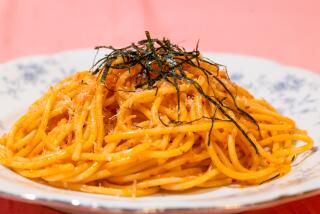Market Scene : Thai Shrimp Farms a Boon--and Bust : New technology has impoverished many small farmers and made millionaires of a lucky few.
- Share via
RANOT, Thailand — Until two years ago, Prasert Kerdtip scraped a meager living from the soil, earning only $80 a year by growing rice. But in 1991, he made $8,000 on his farm and bought his two sons new Kawasaki motorcycles in celebration.
Uan Chotikorn was once a prosperous farmer, earning more than $2,500 a year on her six acres of rice paddy. But now that paddy has turned sterile, and she scrapes out a living by selling sodas at a small roadside stand.
Both farmers, ironically, owe their change of fortune to shrimp--specifically, to the arrival here of a novel farming method to grow saltwater shrimp on land. Their stories add up to a cautionary tale about the disruptive power of high technology--a tale of a shrimp-fed economic boom in Thailand that has simultaneously proved a distinct bust for many of the country’s small farmers and created far more paupers than millionaires.
Shrimp farming has become an enormous business for Thailand, now the world’s leading exporter of prawns. Last year, the country earned $816 million in shrimp exports, mainly to Japan and the United States.
Attracted by the possibility of earning many times their annual profits from rice farming, several thousand farmers along Thailand’s long coastline have already converted their rice paddies into shrimp ponds irrigated with seawater pumped from the ocean nearby.
The landscape, once composed of dusty villages set off by miles of verdant green rice fields, has been transformed virtually overnight. The countryside is veined with the bright blue plastic pipes that provide the saltwater, and rows of small waterwheels on the surface of each pond simulate the ocean’s current. The villages have mushroomed into towns; Ranot has built 38 restaurants in the last two years, and the first pickup truck showroom opened last month.
But there is also a downside. The black tiger shrimp raised by the farmers require huge flows of seawater to survive and grow. The farmers are forced to change the water in the ponds almost constantly, and they dispose of the waste in haphazard ways.
As a result, the waterways around shrimp farms have become poisoned by saltwater, which eventually seeps into farmland. Rice farmers in the region have seen their crops shrivel and die in front of their eyes. Livestock are poisoned by salt. Even the people must now drink rainwater or bottled water.
“A lot of people were hurt,” said Thavisak Sukrat, who works for the Thai government’s agricultural extension office in the south. “Shrimp farming has not proved good for Thailand. The big farmers became millionaires, but small villagers became poor.”
One of the biggest producers is a company called Aquastar, a joint venture between Thai investors and the nutrition arm of British Petroleum. With turnover of $60 million annually, Aquastar produces 9,000 tons of shrimp a year using 350 ponds and a state-of-the-art processing plant, which employs 650 people.
Eon H. Black, Aquastar’s chief executive officer, said shrimp farming has raised the standard of living in the area dramatically, with average wages growing from $400 a year for rice growers to more than $12,000 for the company’s contract farmers.
Black said the main environmental problems came from small farmers known as “wildcatters”--the overwhelming majority of shrimp farmers--who did not install proper irrigation and disposal systems.
“If you’re doing this on a large scale, you’ve got investment behind you and you’ve got to manage the thing for the long haul,” he said.
But as noted by local district chief Amnuay Sornbhaldee--who has written a book about the impact of shrimp farming on rice cultivation--farms near Aquastar’s operations can’t grow rice anymore either.
For the small farmer, who has customarily borrowed $25,000 from a state bank to get started in the shrimp business, there is an enormous temptation to overstock ponds--which produces far higher yields in the short term but leads to such pollution that the pond is useless after five years.
There have already been waves of bankruptcies by shrimp farmers, with so many going broke that large areas of eastern Thailand are now unable to raise either shrimp or rice, leaving the communities devastated.
The arrival of the shrimp farms has also dramatically changed the pattern of life in southern Thailand, which used to measure the passage of time in harmony with the languid cycle of the rice crop.
Sawai Chaikit, a 33-year-old farmer who was forced to adopt shrimp farming when his land became salted by pollution, complained to a visitor that while he is now richer, he is exhausted trying to keep up with the pace of work on his one-acre shrimp pond.
“The work is so hard and there is no time to rest. The shrimp have to be fed six times a day, so there is no time to sleep,” Sawai said. He added that he was considering switching to raising fish because they require less attention.
The arrival of shrimp farming has also created a dramatic gap between the rich, who often ostentatiously display their wealth, and the poor who have lost their farms.
Already, poor farmers have marched in protest outside government offices to complain about the destruction of their water supplies.
“My worry is that crime will become rampant,” said district chief Amnuay. “People don’t have money so they come and steal the shrimp. So far, they’re just stealing, but in neighboring provinces they are killing each other over shrimp.”
More to Read
Sign up for Essential California
The most important California stories and recommendations in your inbox every morning.
You may occasionally receive promotional content from the Los Angeles Times.













